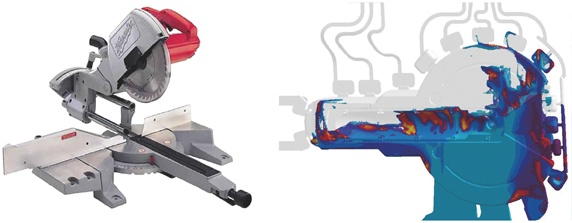Optimization Saves Launch of New Miter Saw
First die trials of a miter saw component produced visually sound castings and the results at the start of production were promising. This changed quickly during machining of the first parts delivered. Small amounts of air were entrapped and tiny porosities could be seen after machining. Having the die built and the design set, the die caster did not have much room to improve the situation. Gates were closed and opened, process parameters were changed, but the problems remained. The launch of the new miter saw was at risk.
The decision was made to simulate the main changes to the die and to compare them with the defect images. First simulation evaluations matched the real-world results, and a design of experiments was developed. Changes of the runner and venting system, as well as process parameter variations, were defined. Using MAGMASOFT®, various simulations were performed fully autonomously without further input of the engineering group. After two short days, a good design was found and implemented. The production of the castings, using the new design, led to a scrap rate after machining that was negligible. The launch of the new saw was saved.
